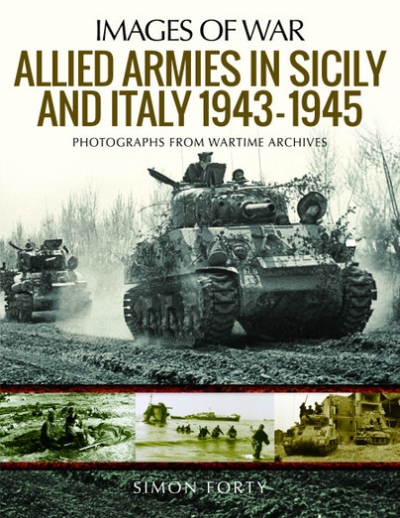| Title: | Allied Armies in Sicily and Italy, 1943-1945 - Photographs from Wartime Archives |
| Writer: | Forty, S. |
| Published: | Pen & Sword |
| Published in: | 2020 |
| Pages: | 144 |
| Language: | English |
| ISBN: | 9781526766205 |
| Description: | And yet another book in the Images of War series. This one is a definite keeper in my library. For one, it provides pictures from many resources and lots of those I hadn’t seen yet in other publications. Always a major benefit! Another reason is that the WW2 stories about the battle in Italy are few and hard to find. That part of the war is especially interesting to me, now that I live here, but also a very important part of World War 2, because the campaign was to tie down a lot of the Axis troops in the run-up to the landings in Normandy and keeping them away afterwards from the Western and Eastern Front. There are also quite a few maps included, showing where the various actions took place. Always important, especially if one isn’t closely familiar with the geography and the names of the local towns and cities. I admit, I am a map buff. With all the above, the book doesn’t provide an in-depth account of all the actions that took place. Some major events are only covered in a few pages, obviously the downside of a limitation in the number of pages. But… the photos and general timeline make up for that. The first part of the book (Setting the Scene) talks about the events leading up to the invasion of Sicily and Italy. Some good information and maps already show up here. Then the next part is about the attack on Sicily (Operation Husky).There is an overview of the opposing forces in that period, a few pages of text, and then the chapter goes on into sub-chapters of the Eighth Army’s campaign and the Seventh Army’s campaign. These parts are fairly short, but with some great photos showing places, troops and equipment and providing good material for scale model diorama builders too. Chapter three moves to the invasion of Italy, after the Sicilian campaign had been won by the allies. This part is mainly about the landings at Salerno and the subsequent battles south of Naples and further inland. Again some excellent photos can be found here. Where the Salerno landings are maybe the most well-known (together with the later Anzio landings), the invasion of Italy actually consisted of three attacks by a large force consisting of US troops, British troops, Canadians and Polish forces. It started on September 3rd 1944 with the attack on Reggio Calabria across the Strait of Messina (Operation Baytown) by the Eighth Army, followed a week later by the attack on Taranto (Operation Slapstick) in the south, and the landings at Salerno (Operation Avalanche) by the US Fifth Army. Specifically page 80 has some interesting detailed information about the various operations at the beginning of the campaign, with the allied trying to move north. And again, lots of great photos. Chapter Four then takes us to the Gustav Line and Monte Cassino, two famous names of the Italian campaign. Towards the end of 1943 the allied advance was slowing down at last. Due to increasing resistance by the Germans, but also very much due to the very difficult terrain and increasingly bad weather. Where it took them only three months to conquer the southern part of Italy, including Naples and the airfields in the area, it was not until May 1944 that they finally were able to take Monte Cassino and open the road to the way north, past Rome. The fact that the allies started their build-up for the Normandy landings by that time meant there were far less troops and material available for the Italian campaign, forcibly stretching it out to over more than a year! The Germans were able to rush in some badly needed reinforcements to tighten up the Gustav Line, resulting in lots of casualties on both sides in a long drawn-out campaign to overcome this defense line. Famous battles like the one in Ortona resulted, where the Canadians alone lost some 4,200 men. Page 86 has a map showing the front line in May 1944, still way south-east of Rome. There were still many battles to come before the allies were again stuck, this time in the north of Italy. Page 94 has an interesting map, showing the attacks after Monte Cassino fell, advancing northwest. Unfortunately the map doesn’t show that the allies were relatively close to Anzio by then, which lay behind the Hitler Line. Chapter Five is about the landings at Anzio and the advance towards Rome. The Germans apparently did not expect yet another landing from the sea, and the landings were hardly opposed, with very few casualties. But that was to change soon when the Germans brought up reinforcements, almost pushing the allies back into the sea. The map on page 98 shows the initial landing area. With hindsight, the Anzio landings may not have been worth the effort, the loss in human life and material. It took the allies over four months to eventually break out and that was much longer than anticipated, with the Gustav Line having fallen already. In the end all the allies achieved was reaching Rome, instead of locking up the German forces retreating from the Gustav Line battles further east. With the fierce resistance of the German forces all through the Italian campaign, the allies were once again stalled by the end of 1944, more than a year after their initial attacks on Sicily. Now the Gothic Line (and the mountainous landscape and bad weather) stood in their way, stopping them from advancing past Bologna and into the Po valley. The ensuing battles are described in Chapter Six. The Germans had set up a makeshift line first (the Trasimene Line, which happens to be the area where yours truly now lives), but that quickly fell… Not so with the Gothic Line which is shown on the map on page 118, running West to East north of Florence. Again a very difficult terrain (even the old modern highway was an affair with dozens of bends and very dangerous, until a new highway consisting of tunnels was opened a few years ago), so ideally suited for defenders. The lack of resources was hampering the allies' efforts too, with the landings in Normandy and the subsequent campaign siphoning much of the war resources in Italy to the western front. So it wasn’t until the spring of 1945, almost a year and a half after Operation Husky that the allies finally could push to the Po Valley and onto the Alps. Bologna only fell into allied hands on April 21st. Chapter Seven, Endgame, has some interesting and amazing figures of the allied losses in Italy during this very long campaign. ‘Interesting’ is maybe the wrong word, when seeing that there were some 13,000 court martial cases for desertion (covering the African, Greek and Italian campaign for the British and Commonwealth troops alone), 10,750 casualties for each British division in the Italian campaign and many casualties by illness. The weather and terrain and the duration of the battles and subsequent waiting were a major factor in all of this and much worse than in the western campaign after Normandy. There’s another map on page 130 showing the last advances in 1945 before the war ended with the surrender of the Germans. Interestingly the allies did not conquer the Alps yet by this time, which would have been another major problem should the Germans not have been defeated elsewhere first. All in all a very good book with tons of interesting photos and providing a concise and useful timeline of the entire Italian campaign. I use it as an indispensable addition to my other books about the Italian campaign which provide more in-depth details on certain parts of the period. Recommended! |
| Rating: |     Zeer
goed Zeer
goed |
Information
- Article by:
- Francois Dumas
- Published on:
- 03-05-2020
- Feedback?
- Send it!




